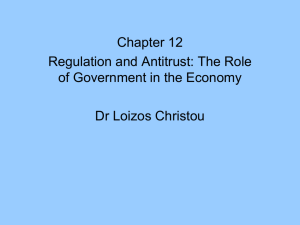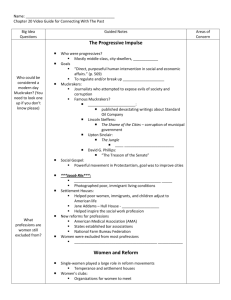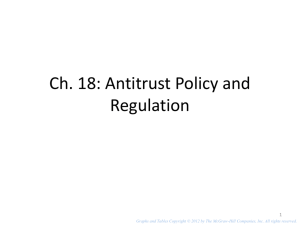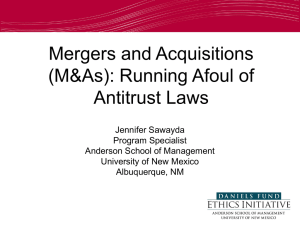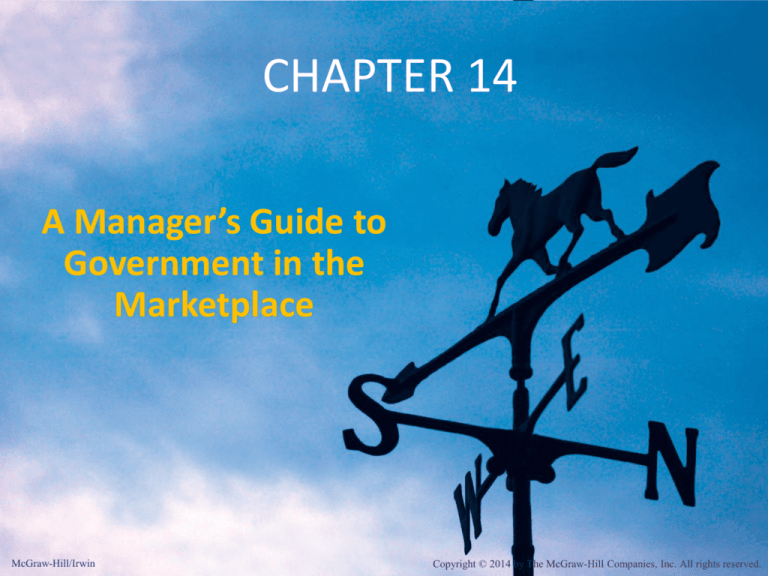
CHAPTER 14
A Manager’s Guide to
Government in the
Marketplace
McGraw-Hill/Irwin
Copyright © 2014 by The McGraw-Hill Companies, Inc. All rights reserved.
Chapter Outline
Chapter Overview
• Market failure
– Market power
– Externalities
– Public goods
– Incomplete information
• Rent seeking
• Government policy and international markets
– Quotas
– Tariffs
14-2
Introduction
Chapter Overview
• Chapter 13 explored several strategies that businesses can
use to change the environment in which they operate:
– Elimination of competition: limit pricing and predatory pricing
– Lessening competition: raising rivals costs, changing the timing of
decision to create a first- or second-mover advantage, and
penetration pricing.
• In contrast to the previous chapters in this book, Chapter 14
examines four reasons why free markets may fail to provide
the socially efficient quantities of goods, and an overview of
government policies designed to alleviate market failures. The
four market failures examined include:
– Market power
– Externalities
– Public goods and incomplete information
14-3
Market Power
Market Failure
• The socially efficient quantity in a market occurs
where price equals marginal cost. This quantity
maximizes the sum of consumer and producer
surplus.
– This socially efficient price and quantity arise naturally in
a perfectly competitive market.
• When a firm in a market produces an output that is
less than the socially efficient level because it
charges a price that exceeds marginal cost, the firm
has market power.
– The value to society of producing another unit is greater
than the cost to produce another unit.
– Government may intervene in the market in attempt to
increase social welfare.
14-4
Market Failure
Welfare and Deadweight
Loss Under Monopoly In Action
Price
Social welfare
𝑃
MC
𝑀
Deadweight loss
MR
𝑄𝑀
Demand
Quantity
14-5
Antitrust Policy
Market Failure
• The purpose of Antitrust policy is to eliminate
the deadweight loss of monopoly by making it
illegal for manager to engage in activities that
foster monopoly power.
14-6
Market Failure
Antitrust Policy: Sherman Act, Section 1
• The cornerstone of U.S. antitrust policy are Sections
1 and 2 of the Sherman Antitrust Act of 1890:
– Section 1: Every contract, combination in the form of
trust or otherwise, or conspiracy, in restraint of trade or
commerce among the several states, or with foreign
nations, is hereby declared to be illegal. Every person
who shall make any such contract or engage in any such
combination or conspiracy shall be deemed guilty of a
felony, and, on conviction thereof, shall be punished by
fine not exceeding five thousand dollars (one million
dollars if a corporation, or, if an other person, one
hundred thousand dollars) or by imprisonment not
exceeding one (three) years, or by both said
punishments, in the discretion of the court.
14-7
Market Failure
Antitrust Policy: Sherman Act, Section 2
– Section 2: Every person who shall monopolize, or
attempt to monopolize, or combine or conspire with
any person or persons, to monopolize any part of
the trade or commerce among the several States, or
with foreign nations, shall be deemed guilty of a
felony, and, on conviction thereof, shall be punished
by fine not exceeding five thousand dollars (one
million dollars if a corporation, or, if any other
person, one hundred thousand dollars) or by
imprisonment not exceeding one (three) years, or
both said punishments, in the discretion of the
court.
14-8
Market Failure
Antitrust Policy: Rule of Reason
• Interpretation of antitrust policy is shaped by the
courts, which rule on ambiguities in the law and
previous cases.
• In the Supreme Court’s ruling on Standard Oil Trust,
the Court defined a new rule of reason, which
effectively stipulates
– that not all trade restraints are illegal; rather, only those
that are “unreasonable” are prohibited.
• Problems with the rule of reason:
– It is difficult for managers to know in advance whether
particular pricing strategies or other actions used to
enhance profits are in fact violations of the law.
14-9
Market Failure
Antitrust Policy:
Clayton and Robinson-Patman Acts
• To make more precise what actions are deemed
illegal in antitrust law the U.S. Congress passed
the Clayton Act (1914) and Robinson-Patman
Act (1936).
– These acts make price discrimination – aimed to
substantially lessen competition or tend to create a
monopoly in the line of commerce, or injure,
destroy, or prevent competition – illegal.
– Price discrimination is permitted under these acts
when
• it arises because of cost or quality differences.
• it is necessary to meet a competitor’s price in a market.
14-10
Market Failure
Antitrust Policy: Clayton Act
• Illegal actions for firms under the Clayton Act:
– Hide kickbacks as commissions or brokerage fees.
– Use rebates unless they are made available to all
customers.
– Engage in exclusive dealings with a supplier unless the
supplier adds to the furnishing of the buyer and/or
offers to make like terms to all other potential suppliers.
– Fix prices or engage in exclusive contracts if such a
practice will lead to lessening of competition or
monopoly.
– Acquire one or more other firms if such an acquisition
will lead to a lessening of competition.
14-11
Market Failure
Antitrust Policy: Celler-Kefavuer Act
• The Celler-Kefavuer Act (1950) strengthened the
Clayton Act by making it more difficult for firms
to engage in mergers and acquisitions without
violating the law.
• Merger policy was furthered changed when new
horizontal merger guidelines were written in
1982; amended in 1984, and revised in 1992,
1997, and 2010.
– Guidelines based on the Herfindahl-Hirschman index
2
(HHI): 𝐻𝐻𝐼 = 10,000 𝑁
𝑤
𝑖=1 𝑖 , where 𝑤𝑖 is firm 𝑖’s
market share.
14-12
Market Failure
Antitrust Policy:
Horizontal Merger Guidelines
• Horizontal Merger Guidelines
– Merger that increases HHI by less than 100 or leads to an
unconcentrated market (post-merger 𝐻𝐻𝐼 < 1,500) is
typically permitted.
– Markets are considered moderately concentrated when the
post-meger results in: 1,500 < 𝐻𝐻𝐼 < 2,500
• Mergers with an HHI in this range and increase the HHI by more than
100 points potentially raise antitrust concerns.
– Markets are considered highly concentrated when the postmerger 𝐻𝐻𝐼 > 2,500.
• Mergers with an HHI in this range and increase the HHI between 100
and 200 points potentially raise antitrust concerns.
– If a merger increases the HHI by more than 200 points and
leads to a highly concentrated market, it is presumed to
enhance market power.
14-13
Market Failure
Antitrust Policy: Hart-Scott-Rodino Act
• The Hart-Scott-Rodino Act (1976) requires that
the parties to an acquisition notify both the
Department of Justice (DOJ) and Federal Trade
Commission (FTC) of their intent to merge,
provided that the dollar value of the transaction
exceeds a certain threshold (currently about $70
million).
14-14
Market Failure
Antitrust Policy: Hart-Scott-Rodino Act
• Following this premerger notification, the
parties of the merger must wait 30 days before
they may complete the merger transaction.
– If the DOJ and FTC determine that further
examination is warranted, a second request is issued
that extends the waiting period. Once the additional
information is requested, the government has
another 30 days to review the information and file a
complaint to block the merger or permit it to move
forward.
14-15
Price Regulation
Market Failure
• The presence of large scale economies may
make it desirable for a single firm to service an
entire market.
– In these instances, government may permit a
monopoly to exist, but regulate its price in effort to
reduce the deadweight loss.
14-16
Market Failure
Regulating a Monopolist’s Price at the
Socially Efficient Level In Action
Price
𝑃
MC
𝑀
𝑃𝐶
Regulated price
Effective demand
Demand
MR
𝑄𝑀
𝑄𝐶
Quantity
14-17
Market Failure
Regulating a Monopolist’s Price Below the
Socially Efficient Level In Action
Price
Deadweight loss
after regulation
𝑃
MC
𝑀
Deadweight loss
before regulation
𝑃∗
Regulated price
Demand
MR
𝑄𝑅
𝑄𝑀
𝑄∗
Quantity
Shortage
14-18
Market Failure
A Case Where Drives the Monopolist Out of
Business In Action
Price
ATC
MC
𝑃𝑀
𝑃𝐶
Regulated price
Demand
MR
𝑄𝑀
𝑄𝐶
Quantity
14-19
Externalities
Market Failure
• Negative externalities exist when costs are
borne by parties who are not involved in the
production or consumption of a good or service.
• The reason externalities cause a “market
failure” is the absence of well-defined property
rights.
• The failure is often resolved when a government
defines itself to be the owner of the
environment, and uses its power to induce the
socially efficient levels of output and pollution.
14-20
Market Failure
The Socially Efficient Equilibrium in the
Presence of External Costs In Action
Socially
efficient
equilibrium
Price
of
steel
Marginal cost to society of
producing steel
(internal and external costs)
C
𝑃𝑆
𝑆=
B
𝑃𝐶
𝑁
𝑖=1 𝑀𝐶𝑖
Free market
equilibrium
(internal costs)
Marginal cost of
pollution to society
(external costs)
A
Demand
0
𝑄𝑆
𝑄𝐶
Output of steel
14-21
Market Failure
Externalities: The Clean Air Act
• To solve the externality problem caused by
pollution, the U.S. Congress passed the Clean Air
Act in 1970 and made sweeping changes with
amendments in 1990.
• Firms that operate in industries that release over 10
tons per year, or 25 tons per year of a combination
of pollutants, on a specified list are required to
obtain a permit to emit pollution into the
environment.
• The Clean Air Act causes firms to internalize the
cost of emitting pollutants since the permits are
costly to acquire.
14-22
Impact of the
Clean Air Act In Action
Market Failure
Price
𝑆𝑢𝑝𝑝𝑙𝑦1
Due to reduction in
output by all firms
𝑃1
𝑆𝑢𝑝𝑝𝑙𝑦0
𝑃0
Demand
0
𝑄1
𝑄0
Market output
14-23
Public Goods
Market Failure
• A public good is another type of good that leads
to a market failure.
• A public good is:
– A good that is nonrivalous and nonexclusionary in
consumption, and therefore, benefit persons other
than those who buy the goods.
• Nonrivalous consumption: the consumption of the good
by one person does not preclude other people from also
consuming the good.
• Nonexclusionary consumption: once provided, no one can
be excluded from consuming the good.
14-24
Market Failure
Public Goods and Inefficiencies
• Public goods leads the market to provide
inefficient quantities since everyone gets to
consume a public good once it is available, but
individuals have little incentive to purchase the
good; they prefer others to pay for it.
– When a group of individuals rely on the efforts or
payments of others to provide a good, we say there
is a free-rider problem.
14-25
Market Failure
Demand for Public a Good In Action
Price
90
𝑀𝐶of streetlights
54
Total demand for streetlights
Individual consumer surplus = $72
30
Individual demand for streetlights
18
0
12
30
Quantity of
streetlights
14-26
Market Failure
Demand for Public a Good In Action
Price
Price
60
𝑀𝐶 of
streetlights
54
Total demand
by B and C
30
27
A’s consumer
surplus from = $85.50
free-riding
30
27
A’s demand
for streetlights
B’s and C’s
individual demand
0
3
30 Quantity
of streetlights
3
30 Quantity
of streetlights
14-27
Incomplete Information
Market Failure
• Efficiently functioning markets require
participants to have reasonably good
information about prices, quality, available
technologies, and the risks associated with
working particular jobs or consuming particular
products.
– Market inefficiencies result when participants have
incomplete information.
– One severe source of market failure is asymmetric
information, where some market participants have
better information than others.
• Implication: buyers may refuse to purchase from sellers.
14-28
Government Policies Dealing
with Asymmetric Information
•
•
•
•
•
Market Failure
Rules against insider trading
Certification
Truth in lending
Truth in advertising
Enforcing contracts
14-29
Rent Seeking
Resource Allocation and Rent Seeking
• Government policies can improve the allocation
of resources to alleviate market failures.
• These policies, however, generally benefit some
parties at the expense of others.
– Implications: lobbyists spend considerable sums in
attempt to influence government policy; a process
known as rent seeking.
14-30
Rent Seeking
Incentives to Engage in
Rent-Seeking Activities In Action
Price
C
𝑃𝑀
𝑃𝐶
A
B
MC = AC
Demand
MR
𝑄𝑀
𝑄𝐶
Quantity
14-31
Government Policy and International Markets
Quotas
• A quota is a government restriction that limits
the quantity of imported goods that can legally
enter the country.
– Implications:
•
•
•
•
Reduces competition in domestic market
Higher domestic prices
Higher profits for domestic firms
Lower consumer surplus for domestic consumers
– Conclusion: Domestic producers benefit at the
expense of domestic consumers and foreign
producers
14-32
Government Policy and International Markets
Quota In Action
Price
𝑆 𝐹 Quota
𝑆𝐹𝑜𝑟𝑒𝑖𝑔𝑛
𝑆 𝐷𝑜𝑚𝑒𝑠𝑡𝑖𝑐
𝑆 𝑄𝑢𝑜𝑡𝑎
Market supply
after quota
E
𝑃𝐷
𝑃𝑄𝑢𝑜𝑡𝑎
𝑃𝐹+𝐷
𝑆 𝐹+𝐷
M
A
K
B
G
𝑄𝑢𝑜𝑡𝑎
Market supply
before quota
Demand
𝑄𝐷
𝑄𝑄𝑢𝑜𝑡𝑎 𝑄𝐹+𝐷
Quantity in the
domestic market
14-33
Government Policy and International Markets
Tariffs
• A tariff is designed to limit foreign competition
in the domestic market to benefit domestic
producers, which accrue at the expense of
domestic consumers and foreign producers.
– Lump-sum tariff: fixed fee that foreign firms must
pay the domestic government to be able to sell in
the domestic market.
– Excise (per-unit) tariff: the fee an importing firm
must pay to the domestic government on each unit
it brings into the country.
14-34
Government Policy and International Markets
Lump-Sum Tariff on a Foreign Firm In Action
Price
Average cost
before
lump-sum tariff
Average cost
After lump-sum tariff
AC2
MC
AC1
𝑃2
𝑃1
𝑞1
𝑞2
Quantity of
individual
foreign firm’s
output
14-35
Government Policy and International Markets
Impact of a Lump-Sum Tariff on
Market Supply In Action
Price
𝑆𝐹𝑜𝑟𝑒𝑖𝑔𝑛
𝑆 𝐷𝑜𝑚𝑒𝑠𝑡𝑖𝑐
𝑆 𝐹+𝐷
A
𝑃2
𝐸
Market supply curve
after lump-sum tariff
Market supply curve
before lump-sum tariff
Quantity in the
domestic market
14-36
Government Policy and International Markets
Quota In Action
𝑆 𝐹+𝑇
Price
𝑆𝐹
𝑆𝐷
Supply after
excise tax
𝑆 𝐹+𝐷+𝑇
C
E
𝑆 𝐹+𝐷
H
B
A
Supply before
excise tax
Demand
Quantity in the
domestic market
14-37
Conclusion
• Market power, externalities, public goods, and
incomplete information create a potential role
for government in the marketplace to remedy
market failures.
• Government’s presence creates rent-seeking
incentives, which may undermine its ability to
improve matters.
14-38

